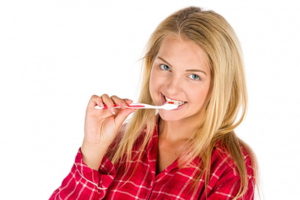Did you know that 50% of people say that the first thing they notice about a person is their smile? This is according to a recent study conducted by the American Academy of Cosmetic Dentistry. If your teeth are discolored, chipped, damaged, or broken, this can affect your ability and willingness to smile. But don’t worry! A healthy, smile is attainable. You just need to follow these tips.
Eat a Healthy Diet
A healthy diet is not only good for our bodies and total health, but also for our teeth! A healthy diet provides the nutrients and fiber we need to keep our teeth strong and free from disease. Eating foods that are high in sugar, starches, and carbohydrates, such as candy, juices, and smoothies can increase the production of plaque acids that attack the enamel of our teeth.
When it comes to a diet that’s great for your teeth, stick to fibrous whole fruits and vegetables, instead of juices or smoothies. The fiber in these whole fruits and veggies helps to naturally rinse away bacteria and food particles from the teeth. Leafy greens also help promote oral health. They are high in calcium and folic acid which may help treat gum disease in pregnant women according to the American Dental Association.
Visit Your Dentist Every Six Months
Visiting your dentist is incredibly important to the health of your teeth. A professional dental cleaning from your dentist every six months will help remove any buildup of plaque and tartar. Plaque is a sticky film that contains bacteria that hardens and becomes tartar. If tartar is not cleaned, it can start to produce acids that damage the bone that supports the teeth. This can cause periodontal disease, which can lead to tooth loss.
Your dentist will also be able to check for plaque, cavities, and any other problems during your checkup. When caught early, teeth and gum problems are much easier to treat, keeping your teeth healthy, pain-free, and sparkling!
Brush Your Teeth

For us baby boomers, you might remember the Crest commercial “I only had one cavity!” Well, a lot has changed since then and a target of zero would be the name of the game these days. But what Crest was trying to convey was that the more you brush your teeth, the better the chances of having fewer or no cavities.
Brushing correctly helps remove plaque. Toothpaste contains fluoride that helps teeth become resistant to decay and even helps remove early decay.
Be sure to gently brush your gums as well as your tongue to remove any food particles and plaque. Dentists recommend motorized brushes, but if you don’t have one, you can use a soft brush. “Hard bristles wear down your tooth structure,” says dentist Maricelle Abayon from Rochester, New York.
Don’t brush your teeth too hard either. The plaque itself is loose and soft, so you don’t need to scrub it. Next time you brush your teeth, tell yourself that you are massaging them, not scrubbing them. Most importantly, brush, and don’t rush! Try turning on the timer on your phone or putting on your favorite song while brushing your teeth. Make sure to brush your teeth between two to three minutes for optimal protection against cavities. According to the American Dental Hygienists Association, “it takes two minutes for the tooth enamel to take in the fluoride in toothpaste, making the tooth surface more resistant to bacteria.”
Floss Daily
Flossing twice daily, along with brushing, is very helpful in removing decay-causing plaque. It is a very important part of maintaining healthy teeth and gums. Flossing regularly might seem like an annoyance, but it takes only a minute or two and helps remove food and bacteria stuck in the spaces between the teeth that brushing or mouthwash can’t remove. When these spaces between the teeth are left unclean, it can lead to plaque and tartar, as well as bad breath! Keep your teeth fresh and healthy by flossing two to three times a day, especially before bed and in the morning.
Stop smoking, including smokeless tobacco
Everyone knows smoking is bad for your health, including your lungs and your heart. Smoking is not just bad for your teeth, but it’s bad for your gums and mouth too. Smoking stains and discolors the teeth, making them turn yellow in just a short amount of time.
Long-term smoking can turn teeth brown, due to the nicotine and tar that’s in cigarettes. Smokeless tobacco can also wear down your teeth which can expose the roots of the teeth leaving them more susceptible to decay. Not only that, but smokeless tobacco such as chewing tobacco allows harmful chemicals to come into direct contact with teeth and gums, causing rapid tooth decay, gum disease, and even oral cancer.
Following these guidelines will help you to maintain a healthy mouth and avoid possible future complications. A little prevention now can go a long way later!
